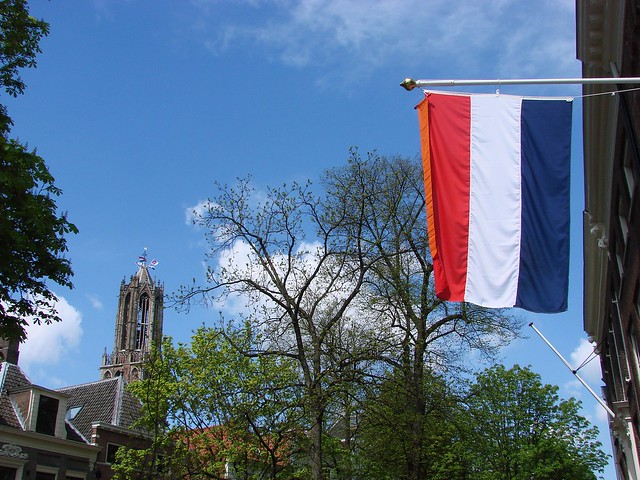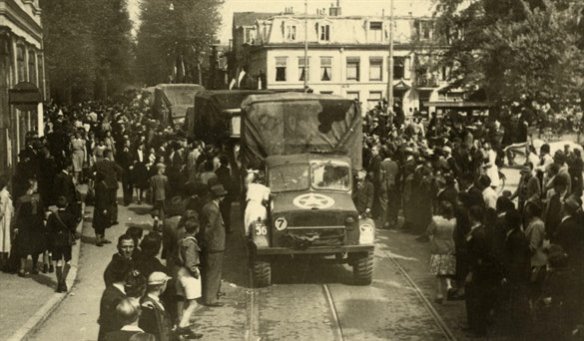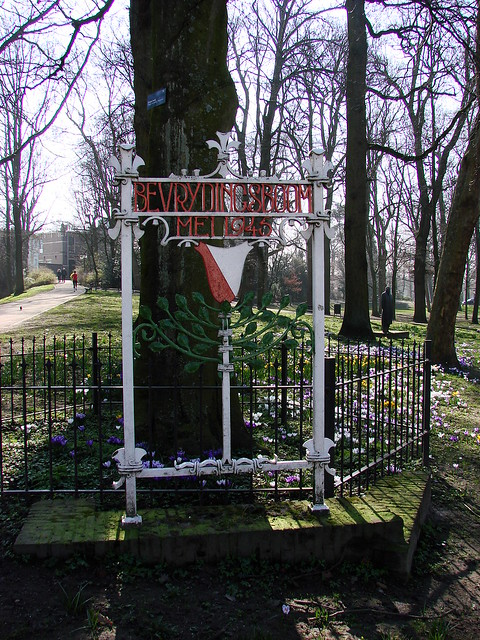 Today is Bevrijdingsdag (Liberation Day) in the Netherlands. It marks the 69th anniversary since the Germans surrendered at the end of World War II and signed the capitulation documents in Wageningen. There are various celebrations held throughout the country today, including here in Utrecht. Today is also one of the official days when the flag is flown and there are flags fluttering in the sunshine across the city and on most streets. Our neighbor is flying the flag and it looks lovely against the bright blue sky.
Today is Bevrijdingsdag (Liberation Day) in the Netherlands. It marks the 69th anniversary since the Germans surrendered at the end of World War II and signed the capitulation documents in Wageningen. There are various celebrations held throughout the country today, including here in Utrecht. Today is also one of the official days when the flag is flown and there are flags fluttering in the sunshine across the city and on most streets. Our neighbor is flying the flag and it looks lovely against the bright blue sky.
Although today marks the liberation of the Netherlands, the full component of allied forces didn’t arrive in Utrecht until 7 May (and later in other areas). However, in the days leading up to their arrival, food began to make its way into the city as part of Operation Faust. Food had been dropped by airplane in various cities in the country and then was gradually distributed to help feed the starving citizens of the Netherlands.
The Utrecht Archives has some photos of the early arrival of these important food deliveries, which I found particularly fascinating and poignant, as many were taken here in my neighborhood. This first one shows some of the trucks arriving on the eastern edge of the city center, having driven up Biltstraat (in the background) and then crossing over to Wittevrouwenstraat. On the right is the turn to Lucas Bolwerk.
 In fact, in this next photo, you can see the trucks lined up along Lucas Bolwerk. There’s a narrow park that runs along this street, with the city ring canal on the other side. It’s where we used to take our dog Pippo every day, so it’s an area I know very well. That makes it seem that much more real and not just a historic photo.
In fact, in this next photo, you can see the trucks lined up along Lucas Bolwerk. There’s a narrow park that runs along this street, with the city ring canal on the other side. It’s where we used to take our dog Pippo every day, so it’s an area I know very well. That makes it seem that much more real and not just a historic photo.
 The final photo is of an allied motorcyclist riding up Voorstraat in the last few days leading up to the liberation of Utrecht. From the waves of the hats, he was surely a wonderful sight to see. And once again, it’s a street I know so incredibly well — in fact, we walked along there on King’s Night last week — which makes it more personal and yet still so hard to imagine.
The final photo is of an allied motorcyclist riding up Voorstraat in the last few days leading up to the liberation of Utrecht. From the waves of the hats, he was surely a wonderful sight to see. And once again, it’s a street I know so incredibly well — in fact, we walked along there on King’s Night last week — which makes it more personal and yet still so hard to imagine. After the liberation of Utrecht, a tree was planted on the south-eastern side of the city, in the park area at the end of the Nieuwegracht. It’s where my beloved Spoetnikkijker statue now stands. The Bevrijdingsboom (Liberation Tree) has a painted, ironwork sign in front of it to mark its commemoration of the liberation of Utrecht and the country in May 1945.
After the liberation of Utrecht, a tree was planted on the south-eastern side of the city, in the park area at the end of the Nieuwegracht. It’s where my beloved Spoetnikkijker statue now stands. The Bevrijdingsboom (Liberation Tree) has a painted, ironwork sign in front of it to mark its commemoration of the liberation of Utrecht and the country in May 1945. Direct links to the photos:Wittevrouwenstraat
Direct links to the photos:Wittevrouwenstraat
Lucasbolwerk
Voorstraat

I married my Dutchboy on May 5th! His family finds it amusing that I (unknowingly!) chose Bevrijdingsdag as the day to get married.
I have to admit that WW II didn’t feel real to me at all until I visited the Netherlands and traveled to sites where my in-laws and heard stories from my in-laws who lived through it. Intimate stories make history come alive, and the past suffering becomes too real and very scary.
Ha! I suppose it is a somewhat ironic day to get married. 🙂
My Scottish grandfather was killed in WWII and I’ve heard stories from my British relatives, so it’s always been pretty real to me in some ways. But the thought of actually living in an occupied country — seeing the photos of Nazi soldiers in places I know so well here — really does make it all so much more than just something to read in a history book. And when you hear the awful stories of the deprivation and the amazing stories of bravery, it really is remarkable.
It’s a lovely day today, the sun is out for Bevrijdingsdag! I always find those photos taken here in the city more poignant. Like you said, actually knowing the streets really makes it hit home more. I do have family members who had horrible tales of the Hongerwinter (Winter of Hunger) when the northern parts of the country were not yet liberated while the south was. Very bleak. I can imagine the city went crazy with joy when liberation finally came!
There’s a lovely flea market in Lombok at the moment btw, held yearly on May 5th.
I’ve heard some of the Hongerwinter stories from other friends, as well, and it really is horrible what they had to go through. It makes the celebration photos all that more poignant and touching. As sad as it all is, it’s also good to have these days to remember it all.
I saw something the other day about the market in Lombok, but didn’t realize it was an annual event. Maybe I’ll make it next year. Enjoy the lovely weather!
Yes they never announce it widely, but it’s been held on May 5th for years now I think (I’ve been at least 5 or 6 times). It’s pretty big, and the atmosphere is always nice, much like Konings-/Koninginnedag.
this one impressed me as well:
http://utrecht.erfgoedopdekaart.nl/#/nico-jesse/een-groep-marcherende-duitse-soldaten-in-de-nachtegaalstraat/foto/
Wow.
It’s been really interesting seeing so many of those photos by Nico Jesse this week thanks to Zo Was Utrecht on Twitter. Fantastic daily scenes.
How interesting to see those old pictures!! I also find it so hard to imagine NL in the war – and yet, a few kilometres away from my apartment, there are whole networks of deserted German bunkers with underground tunnels … so strange.
Oh wow! It’s those kinds of things that can really kind of blow your mind when you stop and think about it.
In my old neighbourhood there’s loads of old bunkers used in both WW1 and WW2. It’s part of the Nederlandse Waterlinie. There’s even an old WW2 jeep standing there, all grown over (in a part not usually open to the public, I saw it when it was open on Fortendag). I’ve also seen the bunkers on the beaches of France. It was really moving to stand there imagining D-Day.
I followed the link to the utrecht archives. What an interesting photos. But I don’t believe some captions of the photos.
Food was not only dropped from airplanes but also brought in by allied trucks from liberated Holland. The allied advance had come to a halt at the waterlinie, a 1940 dutch line of defences and inundations, and a non declared cease fire existed. Utrecht was quite close to the front.
Food deleveries were controlled by the Germans, they decided where to drop and which route to follow. And every vehicle from an allied food delevery convoy had to carry a white flag. I have seen photos from such convoys, and indeed every vehicle carries a white flag.
Therefore I doubt that the photos are from the days before the German capitulation, no white flags on the trucks and most telling the dutch flags flying. I even doubt that it is a food convoy. All those hitch-hiking people hanging from the trucks are typical for the allied entry in the western part of the Netherlands.
Beautiful post! 🙂 I’m curious to pay a visit to that tree.
Thanks for this, Alison. May 7, 1945, is a day I will remember into my dotage. That day units of the Duke of Wellington’s Brigade, 49th (W.R.) Division, liberated Baarn, about 18 km northeast of Utrecht. It was a gorgeous morning, and we were standing along the road from Amersfoort to Amsterdam, just east of the cutoff to Hilversum, cheering and waving little flags as the “Tommies” drove by in their jeeps, half-tracks, and trucks, with a few tanks as well. The mood was one of total, overpowering joy. I was going on six years old at the time, but right now it feels as though it were yesterday.
Thank you for sharing this, Michiel, especially such joyful memories!